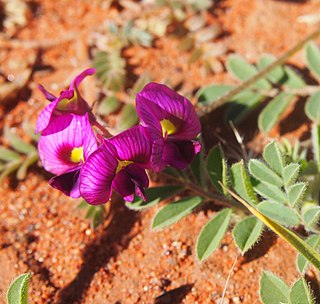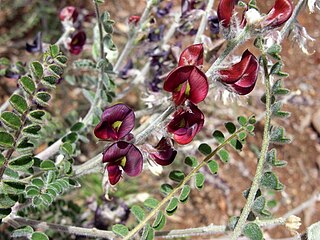
Swainsona behriana, commonly known as Behr's swainsona, is a species of flowering plant in the family Fabaceae and is endemic to south-eastern continental Australia. It is a prostrate or low-growing perennial herb with imparipinnate leaves usually with 9 to 13 narrowly elliptic to egg-shaped leaflets with the narrower end towards the base, and racemes of 2 to 7 purple flowers.

Swainsona colutoides, commonly known as bladder senna or bladder vetch, is a species of flowering plant in the family Fabaceae and is endemic to arid areas of Australia. It is an erect annual, shrub-like herb, with imparipinnate leaves usually with up to 13 to 17 egg-shaped leaflets with the narrower end towards the base, and racemes of 10 to 20 purple flowers.
Swainsona acuticarinata is a species of flowering plant in the family Fabaceae and is endemic to arid areas of central Australia. It is a prostrate perennial herb with imparipinnate leaves with 5 to 11 leaflets, and racemes of purple flowers.

Swainsona beasleyana is a species of flowering plant in the family Fabaceae and is endemic to inland areas of Western Australia. It is a low-lying perennial herb with imparipinnate leaves usually with 15 to 19 egg-shaped leaflets with the narrower end towards the base, and racemes of 3 to 8 pale or dark purple flowers.

Swainsona brachycarpa, commonly known as slender swainson-pea, is a species of flowering plant in the family Fabaceae and is endemic to eastern Australia. It is a prostrate or ascending perennial herb with imparipinnate leaves usually with 9 to 13 egg-shaped to narrowly elliptic or egg-shaped leaflets, and racemes of up to 12 white, purple or dark red flowers.
Swainsona bracteata is a species of flowering plant in the family Fabaceae and is endemic to eastern Australia. It is a perennial herb with imparipinnate leaves usually with 19 to 25 narrowly egg-shaped leaflets, and racemes of about 20 white, pale pink or pale purple flowers.

Swainsona burkei is a species of flowering plant in the family Fabaceae and is endemic to northern Australia. It is a prostrate or perennial subshrub with imparipinnate leaves usually with 5 to 11 oblong to narrowly egg-shaped leaflets, and racemes of 5 to 10 purple flowers.

Swainsona burkittii, commonly known as woolly Darling pea, is a species of flowering plant in the family Fabaceae and is endemic to inland Australia. It is an erect or low-lying perennial with imparipinnate leaves usually with 15 to 30 egg-shaped to more or less circular leaflets, and racemes of up to fifty dark reddish-purple flowers.
Swainsona cadellii is a species of flowering plant in the family Fabaceae and is endemic to inland New South Wales. It is a shrubby perennial with imparipinnate leaves usually with 5 to 15 mostly narrowly egg-shaped leaflets, and racemes of 15 to 20 white, pink or purple flowers.
Swainsona calcicola is a species of flowering plant in the family Fabaceae and is endemic to north-western Western Australia. It is a prostrate or ascending, low-growing perennial with many stems, imparipinnate leaves usually with 7 to 11 broadly egg-shaped leaflets with the narrower end towards the base, and racemes of usually 4 or 5 pink, purple or red flowers.

Swainsona campestris is a species of flowering plant in the family Fabaceae and is endemic to arid areas of southern Australia. It is an erect perennial herb with imparipinnate leaves with 9 to 11 linear to narrowly lance-shaped leaflets, and racemes of pink or purple flowers in racemes of 5 to 10.

Swainsona campylantha, commonly known as Gilgai Darling pea, is a species of flowering plant in the family Fabaceae and is endemic to inland areas of Australia. It is a low-growing perennial with imparipinnate leaves usually with up to 7 narrowly lance-shaped to narrowly elliptic leaflets, and racemes of 2 to 10 pink to purple flowers.
Swainsona cyclocarpa is a species of flowering plant in the family Fabaceae and is endemic to northern inland areas of Australia. It is a prostrate or low-growing annual with imparipinnate leaves usually with up to 7 usually egg-shaped leaflets with the narrower end towards the base, and racemes of 4 to 16 purple flowers.
Swainsona decurrens is a species of flowering plant in the family Fabaceae and is endemic to northern inland areas of Australia. It is an erect annual with imparipinnate leaves usually with 15 to 19 narrowly elliptical leaflets and racemes of 20 to 30 red or purple flowers.
Swainsona dictyocarpa is a species of flowering plant in the family Fabaceae and is endemic to central areas of South Australia. It is a small erect perennial herb with imparipinnate leaves with 3 to 7 elliptic leaflets, and racemes of purple flowers in racemes of 2 to 6.
Swainsona disjuncta is a species of flowering plant in the family Fabaceae and is endemic to widely separated areas of central Australia. It is a prostrate perennial herb with imparipinnate leaves with 3 to 9 egg-shaped leaflets, and racemes of purple, pink or red flowers in racemes of 3 to 15.
Swainsona ecallosa is a species of flowering plant in the family Fabaceae and is endemic to central Western Australia. It is an erect, single-stemmed, annual herb with imparipinnate leaves with about 17 narrowly egg-shaped leaflets, and racemes of purple flowers in racemes of up to 20.

Swainsona elegans is a species of flowering plant in the family Fabaceae and is endemic to Western Australia. It is a prostrate or ascending annual with imparipinnate leaves, usually with 7 to 15 egg-shaped or elliptic leaflets, and racemes of up to 15 blue or reddish-purple flowers.
Swainsona elegantoides is a species of flowering plant in the family Fabaceae and is endemic to north-western Western Australia. It is an erect, probably annual plant with imparipinnate leaves, with about 11 narrowly egg-shaped leaflets, and racemes of 15 to 25 purple flowers.
Swainsona eremaea is a species of flowering plant in the family Fabaceae and is endemic to South Australia. It is a low-growing, spreading, probably perennial plant with imparipinnate leaves with 5 to 11 linear, oblong to broadly wedge-shaped leaflets, and racemes of bright red to brown or yellow flowers in racemes of 5 to 20.








